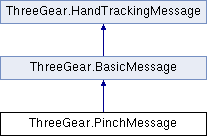 |
3Gear Systems SDK
v0.9.34
|
 |
3Gear Systems SDK
v0.9.34
|
Messages relating to pressing, releasing, dragging and moving of each hand. More...

Public Member Functions | |
| PinchMessage (MessageType type, Hand hand, Vector3D positionLeft, Quaternion rotationLeft, int clickCountLeft, Vector3D positionRight, Quaternion rotationRight, int clickCountRight) | |
| override string | Serialize () |
| Serialize the message to a string, which could then be sent using the network protocol. More... | |
Static Public Member Functions | |
| static new PinchMessage | Parse (TokenStream tokenStream, MessageType type) |
Protected Member Functions | |
| PinchMessage (BasicMessage message, Hand hand) | |
Protected Attributes | |
| Hand | hand |
Properties | |
| Hand | Hand [get] |
| Which hand the message returns to (left or right). More... | |
Additional Inherited Members |
Messages relating to pressing, releasing, dragging and moving of each hand.
Pinch messages are always a single hand at a time. That is, if the user pinches left and right simultaneously, you will still get two separate PRESS messages (one for the right and one for the left). As a result, there is less lag for pinch messages (which can be reported as soon as they happen) than for the "higher-level" BimanualPinchMessage messages.
Note that we do not recommend responding to both the PinchMessage and the BimanualPinchMessage; applications should generally pick one or the other. Responding to both can lead to very confusing interactions (since most pinches will be detected at least twice).
|
inlinevirtual |
Serialize the message to a string, which could then be sent using the network protocol.
Reimplemented from ThreeGear.BasicMessage.
|
get |
Which hand the message returns to (left or right).
 1.8.3.1
1.8.3.1